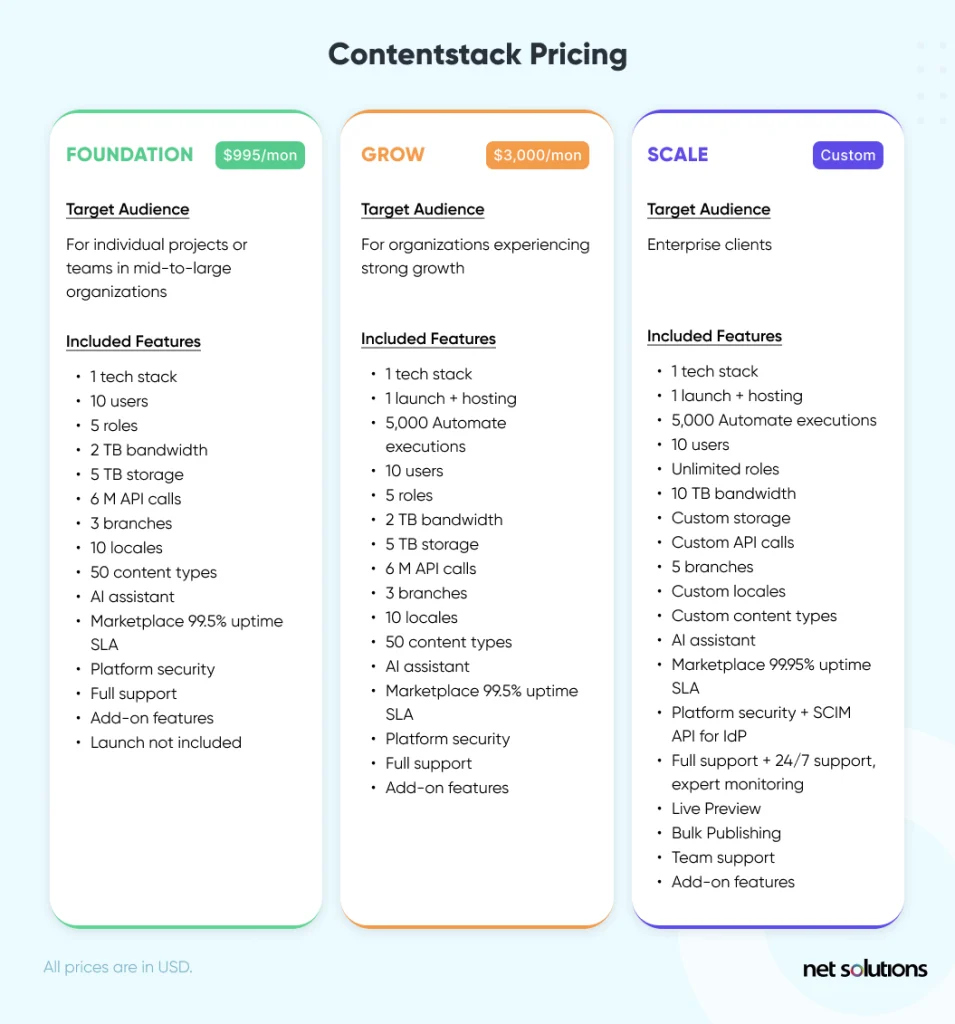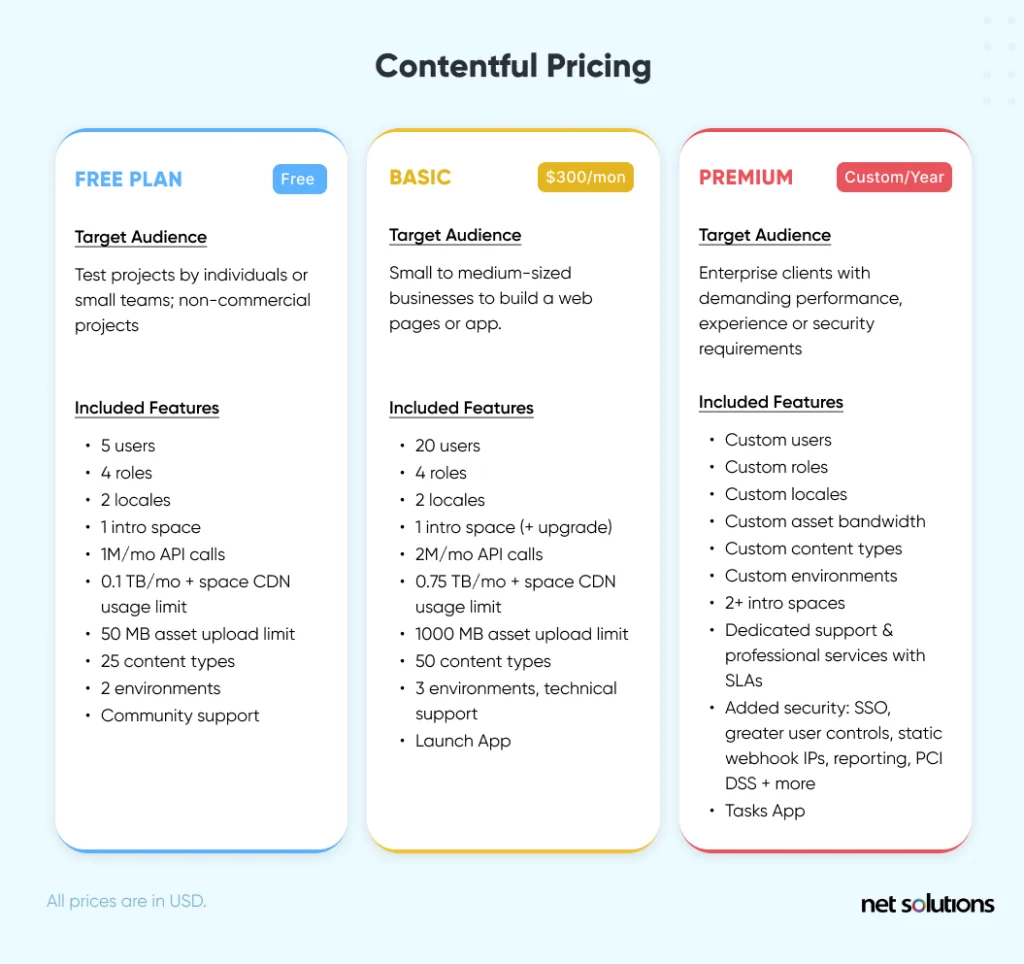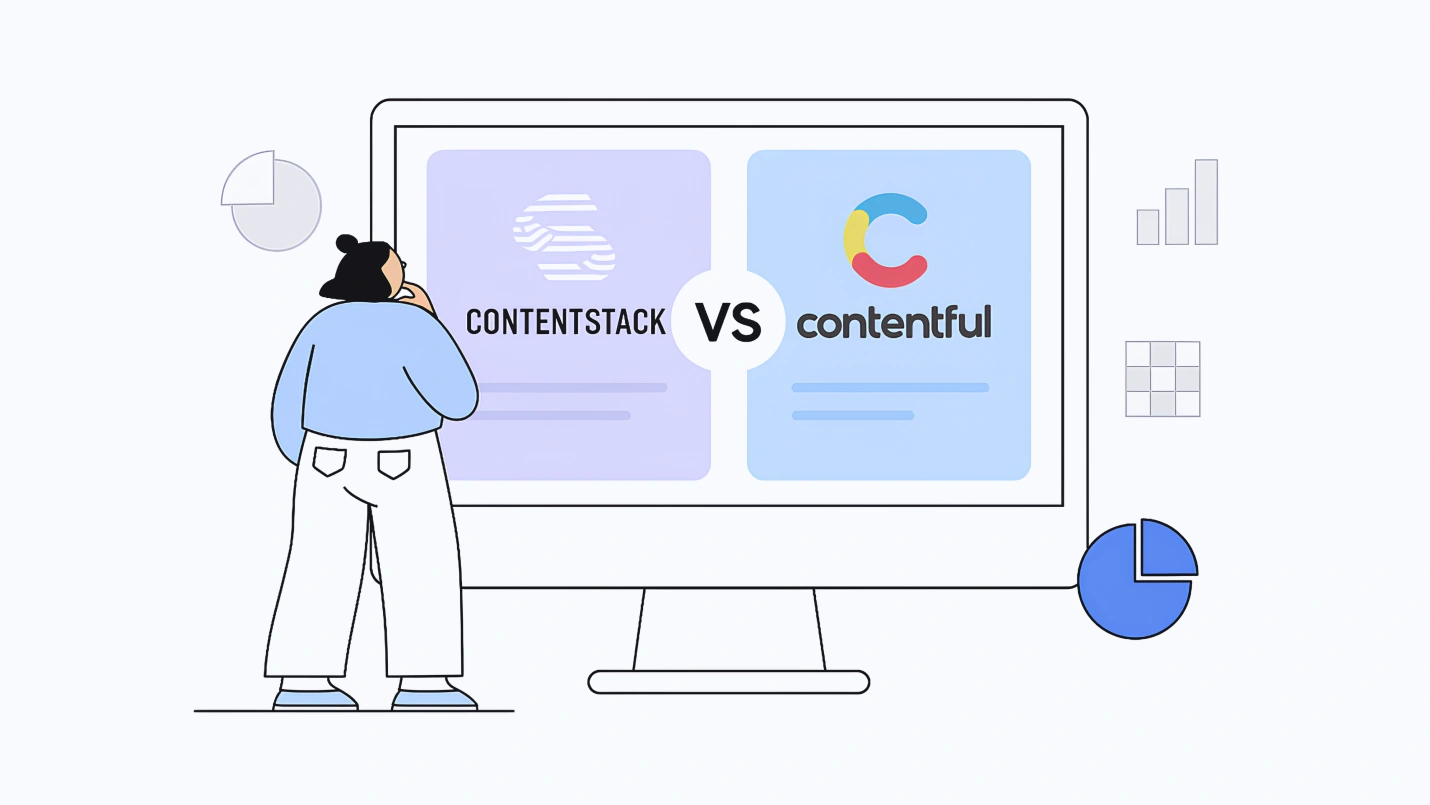The main difference between Contentstack and Contentful is front-end hosting: Contentful does not include the option for front-end hosting while Contentstack does.
Digital experiences are becoming increasingly important to attracting and retaining customers and meeting business objectives. Choosing the right content management system (CMS) to power those digital experiences is thus a very important discussion. And in an era of omnichannel experiences, developers, marketers, and business leaders are all looking to the increased flexibility of headless CMS platforms such as Contentstack and Contentful.
This post will offer a straightforward comparison between Contentstack and Contentful, detailing the features of each platform, including price, and the benefits and drawbacks of each platform. Read on for help in your decision on which headless platform to use to create and optimize your website, app or online store, to help facilitate efficient content management and delivery, and support your digital strategy and growth ambitions
Disclaimer: The information below is accurate as of June 7, 2024.
What is a Headless CMS?
A headless CMS such as Contentful or Contentstack separates the front-end (what you see) and the back-end (where content resides) support composable content that can be reused across an endless number of front-ends / channels (web, smartphones, social media, etc), with the ability to optimize how content is delivered and seen by each digital channel. This is differentiated from more traditional CMS that is a single stack and optimizes for one channel (e.g. web), often resulting in the need for multiple CMS implementations and a sub-par customer experience.
“One of the primary reasons for moving to a headless CMS is the ability to seamlessly customize the interface and backend operations. The backend control that Contentful offers allows developers to manage the entire content infrastructure, making it preferable over traditional CMS systems, where such flexibility is limited.”
Senior Full Stack Developer, Entertainment Industry
Contentstack Overview
Contentstack is a headless CMS, founded by Neha Sampat in 2018, based out of San Francisco. Although a relative newcomer on the market compared to some other CMS systems, Contentstack powers more than 3,680 current customers and supports some of the world’s top brands, including Burberry, Walmart, Alaska Airlines and Mattel. Contentstack is currently listed as a “Strong Performer” for Digital Experience Platforms.
Key Features of Contentstack
Contentstack styles itself as both a headless CMS for its foundation plan, as well as a composable DXP (digital experience platform) for its two higher tier plans. Technically, Contentful also meets the mark for a digital experience platform, integrating seamlessly with other tools and services to create amazing digital experiences. To set the two DXP platforms apart, let’s let the features do the talking:
1. Contentstack AI
The Contentstack AI leverages Generative AI (GenAI) throughout the platform to save time, simplify operations (workflows, governance, reports) and support content development within the authoring experience (outlines, ideas, summaries, translations). Includes the option to add personalization to content without the need for third-party services.
2. Contentstack Automate
Provides full-stack automation of routine tasks using pre-built “recipes” from the Marketplace (add-on) to integrate apps & tools faster, eliminating middleware development or infrastructure, and improved automation of content workflows.
3. Contentstack Launch – front-end hosting
Contentstack Launch is included (1 launch) at Grow+ plan levels or as an add-on, providing a full-integrated MACH-compliant front-end hosting experience on Contentstack infrastructure. Supports any common JavaScript front-end framework, with automatic configuration for Nextjs and Gatsby.
4. Apps and integrations
The Contentstack Marketplace includes integrations to a limited number of third-party services and accelerator features, with the ability to request an app that is currently not supported.
Advantages of using Contentstack
Contentstack is designed to speed up content creation and streamline operations with leading edge automations and the option for full-stack hosting.
1. Simplified development
Write applications with technologies, languages or frameworks if the choice. With Launch, developers can support composable architecture but within one environment, reducing the amount of work to manage API keys and leveraging accelerated development with pre-built component libraries and workflows, staging and production environments, deployment webhooks, and integrated messaging with Slack. Contentful supports a variety of SDKs and also provides starter templates to deploy across the stack.
2. API support
Contentstack delivers content to any channel on any device thanks to an API-first design, with API support for:
- Content Delivery API (CDA) to retrieve content to display
- Content Management API (CMA) to create or update content
- Image Delivery API to retrieve and/or transform images
- GraphQL Content Delivery API to retrieve published and unpublished content using GraphQL
- Automate Management API to manage projects, automations, execution, audit log and accounts
- SCIM API to support users via an IdP client (included at Scale or add-on)
3. Localization
Includes an impressive 10 starter locales in base two pricing tiers, with expansion to unlimited for the highest Scale tier. Supported by modular content and guardrails to ensure consistency across globally supported markets. Supports over 200 languages.
4. Easy to use
Contentstack is easy for creative professionals (content editors, marketers), with a visual editor, no limits on assets, and modular blocks for content. It’s easy to drag and drop to create new experiences. Supports independent workspaces to allow team members to work on different content models without disruption to existing efforts in production.
5. Built for scale
Even the lowest tier includes generous limits for bandwidth, storage and API calls, allowing organizations to better anticipate budget and support sudden shifts in scaling needs.
6. Security
Contentstack includes the same level of security across all plan tiers, including SSO, support for multi-factor authentication (MFA), user and role support, multi-region delivery infrastructure and certifications for ISO 27001, SOC 2 Type 2, GDPR and CCPA. Additional security is available for North American or European data centers (add on cost).
7. Support
All plans include extensive documentation, learning courses, and access to a customer success manager. Additional customer support for onboarding and migration are available at an added cost. Scale users receive access to 24/7 support and expert monitoring.
Drawbacks of using Contentstack
While every platform has features that users love, there are also features of Contentstack that some find challenging:
1. Rate limits
By default, the Contentstack Management API enforces the following rate limits, which can push toward the need for a pricier custom plan. Rate limits at standard are:
- Read (GET) requests: 10 requests per second per organization.
- Write (POST/PUT/DELETE) requests: 10 requests per second per organization.
2. Challenges in content modeling
The content model cannot be edited, so any mistakes require a new content model. The content modeling capabilities are a bit challenging and more ideally suited to straightforward (vs complex) content models.
3. Customization limitations in Contentstack
There are only a limited number of available applications available in the Contentstack Marketplace, likely leading to higher web developer requirements to support existing services within the tech stack.
4. eCommerce
While Contentstack does support eCommerce thanks to its headless, API-first nature, there are currently only 10 integrations available for the hundreds of eCommerce platforms that may be available, so custom development of an app or extension would be required for many existing tech stacks.
5. Design limitations
There are no prebuilt design themes, limiting the ‘ease of use’ of the entire platform in comparison with others on the market. Furthermore, Contentstack does not prompt to ensure compliance with accessibility standards such as WCAG.
6. UI limitations for localization
The Contentstack UI is currently only available in English, but this is likely to be adjusted in the next year.
7. Features locked behind paywall
Many of its best features, some of which are basic (e.g. live preview), are locked behind paywalls as add-on features or features only available at the highest price tier.
8. Continuity issue with languages
Note, while localization features are growing, there may be some limitations in how user language preferences are managed by the end customer or ensuring cross-channel continuity in language preferences.
9. High cost
The base level pricing tier is still costly (no free version), with many of the features only available at the highest level. With custom pricing, however, you can add or remove entitlements to try to remain on budget, but the focus is definitely on enterprise clients.
How much does Contentstack cost?
Contentstack offers three tiers of pricing plans, but actual price will depend on the entitlements that are agreed upon in the contract as many plans can include significant numbers of add-on features or services. We have included an estimate of each pricing tier from our research (source here).
All plans include basic platform features such as a content delivery network (CDN), APIs, webhooks, custom fields, workflows, unrestricted environments, digital asset management (DAM), versioning, and analytics.
Contentstack Pricing Plans

Contentful Overview
Contentful is a headless CMS, helping you manage, assemble and deliver content in record time to anywhere you want. A self-titled “composable content platform for digital-first businesses,” Contentful was founded in 2013 and supports nearly 30% of Fortune 500 companies including KraftHeinz, KFC, DocuSign, Staples, Vodafone and BMW.
Key features of Contentful
1. Content Hub
The Contentful Content Hub supports your entire content infrastructure, helping eliminate costly workarounds and duplicate content, unifying disparate sources for editors, and reducing the complexity of managing multiple code bases for developers.
2. Content Studio
In addition to the standard Contentful platform and its tools for content editors, the paid add-on Content Studio leverages a drag-and-drop canvas, patterns and design tokens to speed up content development without developer resources, relying on controls to lock in brand consistency and integrity across channels and markets.
3. Extensions & Integrations
Contentful can be customized as desired using publicly available apps in its Marketplace or custom apps to support third-party services, using the helpful Contentful App Framework.
4. Contentful AI
Contentful now offers AI enhancements to support the building of content models, content generation, translation, generate images, and automate common workflows.
Looking for a CMS tailored to your business needs? Learn about 10 critical questions to ask when selecting a CMS.
Read MoreAdvantages of using Contentful
Although Contentful has long been applauded for being “developer friendly,” the truth is that with the Rich Text editor and new visual editing tools in its Content Studio, Contentful is becoming as intuitive and easy to use for users familiar with interfaces like those on WordPress. Today, Contentful is one of the top 10 most popular CMS platforms.
1. Enhancements and customization in Contentful
Contentful is both customizable (thanks to the Contentful’s UI extensions feature) and extensible, thanks to the Contentful Marketplace for pre-built apps and the Contentful App Framework to make custom web apps to integrate with third-party systems.
2. API versatility in Contentful
Contentful supports a variety of APIs including:
- Content Delivery API (CDA) to retrieve content to display in JSON
- Content Preview API (CPA) to retrieve unpublished content
- Content Management API to create or update content
- Images API to retrieve and/or transform images
- GraphQL Content API to retrieve published and unpublished content using GraphQL
- User Management API to manage users
- SCIM API to manage memberships and teams
3. Efficient content approval process
To support content, you can download and install the Tasks app from the Marketplace to assign work to colleagues or teams and support the content pipeline from creation (Compose) to deployment (Launch).
4. Adaptive content management in Contentful
Contentful supports complex content modeling using its Visual Modeler or standard Content Model tab. This careful planning helps create the basis of supporting a reusable content structure and is ideal for complex content relationships (multiple content inputs, globalization) with strict governance controls.
5. Localization
Leverage ‘Locales’, modular content, AI and third-party tools to accelerate global content creation and up to 100 current languages. Includes 2 locales (free plan) or custom locales at Premium.
6. eCommerce
Supports composable commerce, eCommerce platforms directly into your content editor to control product information, create a shoppable lookbook, promotions, or other interactive and personalized shopping experiences.
“Contentful empowers marketing and e-commerce teams to work independently, reducing their reliance on technical teams. This allows non-technical users to quickly manage and publish content, freeing developers to focus on higher-value tasks. This decentralization of content operations aligns with broader organizational goals to streamline processes and increase agility. Contentful’s API-first framework facilitates integrations with essential tools such as CRM platforms and e-commerce solutions. Professionals noted the ability to seamlessly connect platforms like Klaviyo and Shopify, ensuring content consistency across multiple digital touchpoints.”
Senior Technical Project Manager, eCommerce
Drawbacks of using Contentful
When making your decision, consider some of the following reasons you may not want to use Contentful (if these items are important to you):
1. Content modeling can be challenging
While a huge plus for sites that are complex or for global brands, setting up appropriate content models can be challenging and present downstream problems if not set up correctly. However, Contentful does allow for content models to be edited.
2. Complex set up
The implication of leveraging Contentful development services is that developers need to spend time setting up Contentful’s data model and all the front-end systems and integrations in the tech stack that will ultimately support this simplified content distribution system. Developers not knowledgeable in Contentful or in various front-ends can result in projects that experience delayed time-to-market.
3. Migration barriers with Contentful
Content migration is challenging if ever you decide to leave Contentful, as the Contentful approach to data modeling is differentiated from other CMS systems, requiring more complex data mapping.
"Migrating from legacy systems to Contentful presents challenges, specifically mapping content from platforms like Twill into Contentful’s schema. Ensuring that content from multiple entities works harmoniously under a unified structure is no easy task."
Senior Full Stack Developer, Entertainment Industry
4. API Rate Limits
API rate limits may be a barrier to scaling efficiently or exceeding budgets.
5. The cost of using Contentful
With only a limited number of plans, it very quickly becomes obvious that most users will migrate to the more costly Premium plan to access the resources needed to support the business needs.
In addition, various limits on the account (e.g. API calls) can result in costly overages.
How much does Contentful cost?
Contentful has two products, the Contentful Platform (pricing below) and the Contentful Studio (custom pricing).
Contentful Pricing Plans

Contentstack vs Contentful: Full Comparison
To help people and businesses discover the difference between Contentstack and Contentful, we’ll compare the two platforms to demonstrate which is easier to use, more powerful, can grow with their needs, works well with other tools, and fits their budget.
1. Ease of use
The winner: tie
The platform should be easy to use for all types of users, including those working in content management, business owners, and developers.
Contentstack
Intuitive editing and drag-and-drop features are supported by the (paid) Automations and (paid) AI integration to boost content editing and developer operations. Strong tutorials.
Contentful
Although originally designed with developers in mind, new features such as the Contentful studio are making it easier than ever to create experiences. Comprehensive documentation and helpful community.
2. Data query and content modeling features
The winner: Contentful
The ability to create a taxonomy structure for content (content model) and meaningfully retrieve data from storage can directly impact the ease of use of the CMS.
Contentstack
Contentstack content taxonomies follow a standard flow of content type and fields, but this simplistic approach is more appropriate for simplistic taxonomies. Includes controls for content to enforce brand consistency.
Contentful
Contentful content modeling supports complex content structures and helps create content blocks that can be reused across experiences with explicit controls to enforce brand consistency.
3. Customizability and appearance
The winner: Contentful
In the real world, there’s a big difference between building a website and building an app – you simply need different things from your tools. The ideal CMS will allow you to customize your interface.
Contentstack
Support for custom fields. Ability to use UI Locations to extend the Contentstack platform experience across a limited number of modifications.
Contentful
Integrate custom UI elements using the UI extensions SDK to ensure the interface editors meet your organization’s needs. Support for custom fields.
4. Scalability options and performance
The winner: tie
The ideal CMS will have the ability to scale and maintain performance levels as the organization expands or as the volume of web traffic increases.
Contentstack
Built for enterprise customers with generous enterprise-grade performance limits across plans and up to 99.99% uptime. CDN is unspecified. Supports standard SEO capabilities.
Contentful
Built to support even the largest enterprise needs, offers transparency over performance and uptime here, using Fastly and CloudFront. Lower price plans likely exceeded quickly due to performance limits. Supports standard SEO capabilities.
5. Compatibility with other software and tools
The winner: Contentful
Organizations want to ensure there are no complications in integrating the CMS with existing digital ecosystems, including e-commerce platforms, CRM systems, and marketing automation tools.
Contentstack
The Marketplace includes integrations to a limited number of third-party services, requiring a greater amount of custom app development to support the tech stack.
Contentful
Supported by a growing Marketplace with the benefit of the ability to quickly create custom apps using the Contentful App Framework.
6. Support and resources
The winner: tie
A CMS platform should be well supported by documentation and include both community support and direct support from the platform provider.
Contentstack
Includes full support for every pricing tier, with additional support at the highest tier (24/7 support and expert monitoring) or as an add-on element. Community support is not as strong.
Contentful
Strong community support at base level, but no included support resources until higher two tiers. Highest tier includes dedicated support & professional services with SLAs
7. Security features
The winner: Contentstack
It is critical to ensure security and compliance with industry standards and regulations, while also keeping up with updates to protect against vulnerabilities.
Contentstack
Security features are included in all plans including SSO, user and access controls, multi-region delivery infrastructure and certifications for ISO 27001, SOC 2 Type 2, GDPR and CCPA. Additional security is available for North American or European data centers (add on cost).
Contentful
Security at all plan levels include encryption, firewall, threat detection and backups, but additional security features around identity and access management support for SSO, static webhook IPs, reporting and PCI-DSS are limited to the Premium plan.
8. Price
The winner: Contentful
It’s critical to balance budgetary considerations with the need for a robust CMS that supports a wide range of functionalities and growth plans without incurring excessive costs.
Contentstack
Includes more in its base platform capabilities, but starts pricing tiers at a higher price point with many add-on capabilities. No free plan, only a free trial.
Contentful
Includes a free plan and paid plans with additional features, but likely will require a quick adjustment to the Premium plan to move past limits on performance and capabilities. Winner based on greater pricing transparency.
Choosing Between Contentstack and Contentful
We’ve aimed to offer a straightforward, fair comparison between Contentstack and Contentful, showcasing what sets each apart and where they might fall short. You might want to choose each platform based on the following:
What is Contentstack best for?
Contentstack is ideal for enterprise organizations that are leaning towards a full-stack style environment, still supporting MACH and composable architecture, but with the benefits of a simplified environment to build a website or web app.
What is Contentful best for?
Contentful is ideal for medium to large enterprises to manage and deliver content across multiple channels or platforms, including websites, mobile apps and eCommerce.
Ready to get started?
If you’re a content editor, developer or business owner wanting to develop omnichannel experiences that delight your customers, you’ve chosen well with headless CMS and DXP platforms Contentstack and Contentful. If you want help deciding which platform is best for you, Net Solutions offers end-to-end software development consulting services to help you make the right decision – and then execute on that vision in record time.
Net Solutions is a global, award-winning Agile software development company that specializes in creating seamless multi-platform digital experiences. Net Solutions is a proud partner with Contentful and has vast experience with developing headless CMS platforms.
Frequently Asked Questions
Contentstack and Contentful are both headless CMS / DXP platforms that offer customers high-performance and rich features to create omnichannel experiences anywhere you want, Contentstack starts at a higher price point with more base features and performance limits included in its base platform, but also including more ‘regular’ features as add-on prices. Contentstack also features rich automation, AI and full-stack capabilities with front-end hosting. Contentful offers a free plan and a mid-size plan ideal for smaller clients, but most capabilities are captured in its premium Plan. New AI and Content Studio features make Contentful easy to use, with much time devoted to doing things ‘right’ on the development side (e.g. content modeling, content blocks) to simplify experience generation. While both feature Marketplaces for extensibility, Contentful’s marketplace is larger.
Both Contentstack and Contentful support multilingual content with the use of ‘locales’ and built-in localization features such as AI to help translate content into multiple languages within the same space. While Contentstack boasts up to 200 languages to Contentful’s 100, the taxonomy for creating languages (e.g. Spanish Mexican vs Spanish Argentina) can create issues.
Contentstack and Contentful both prioritize user-friendliness for non-technical users to create and manage digital content efficiently, including rich text interfaces and drag-and-drop capabilities (Content Studio capability, paid for Contentful). Contentstack and Contentful both may present some learning curve for non-technical users, but user experience is supported by tutorials and documentation. Both require developers to support the full tech stack and setup.





